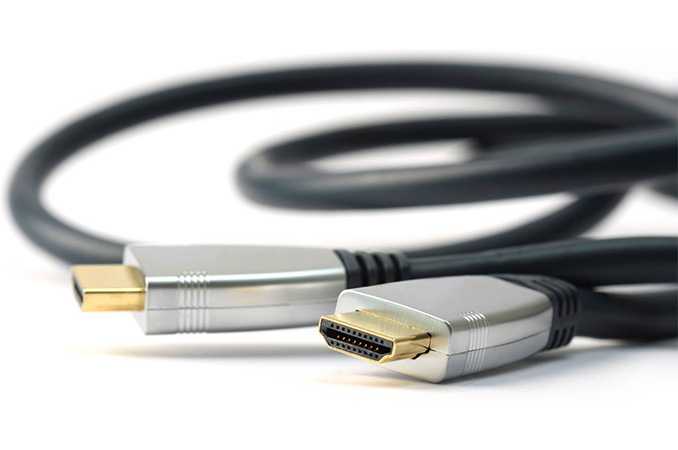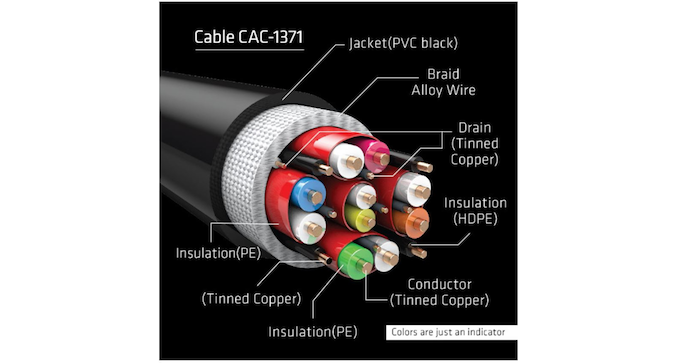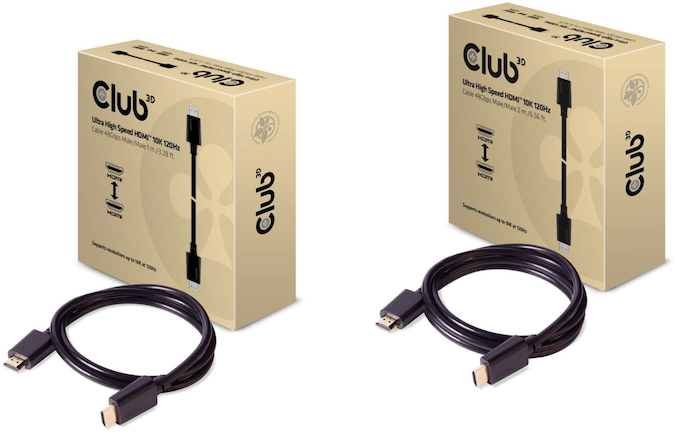HDMI 2.1 Nears Release: Club3D Announces Ultra-High Speed 48G Cable
by Anton Shilov on November 29, 2018 12:00 PM EST
As the first HDMI 2.1-enabled TVs are approaching release, we're finally seeing the market for HDMI 2.1 accessories fall into place to support those products. To that end, Club3D has announced the company’s first Ultra-High Speed HDMI 2.1 cables, which as per the UHS designation, are capable of supporting 48Gbps data rates. The new cables are aimed at next-generation UHDTVs featuring resolutions of up to 10240×4320 at 120 Hz with DSC 2.1 compression. Club3D’s new products fully support all of the features that the HDMI 2.1 spec calls for, so they should be future-proof and will handle everything that the consumer electronics industry will have to offer for years to come.
Club3D will offer two versions of its Ultra-High Speed 48G HDMI 2.1-supporting cables: the one-meter long CAC-1371 and the two-meter long CAC-1372. Both cables feature four data lanes operating at 12 Gbps each for an aggregate bandwidth of 48 Gbps, and as per the HDMI spec, retain backwards compatibility with existing equipment.
The ample bandwidth HDMI 2.1 provides enables it to support new UHD resolutions an refresh rates including, including 4Kp120, 8Kp100/120, 10Kp100/120, and upcoming color spaces, such as BT.2020 (Rec. 2020) with 10, 12, or even more advanced with 16 bits per color component. In fact, high resolutions and bit depths eat up 48 Gbps of bandwidth quickly, so for anything higher than 8Kp60 with 4:2:0 chroma sub sampling and 10-bit color, VESA’s DSC 1.2a link compression technology is used.
Besides new resolutions, refresh rates, and HDR bit depths, HDMI 2.1 support a number of new capabilities, including Variable Refresh Rate (VRR), Quick Media Switching (QMS), Quick Frame Transport (QFT), and eARC. The new features do not require UHS HDMI 2.1 cables for today’s content with up to 4Kp60 resolution with 4:4:4 chroma subsampling. Meanwhile, a combination of 4Kp120/4:4:4 and VRR will entail 48G cables.
Club3D has not announced pricing of its 48G HDMI 2.1 cables, but keeping in mind that the new cables are more complex to assemble than their predecessors, expect them to be more expensive than regular 18Gbps HDMI 1.4/2.0 cables.
Related Reading:
- HDMI 2.1 Specification Released: Variable Refresh, Dynamic HDR, & More In 2018
- HDMI 2.1 Announced: Supports 8Kp60, Dynamic HDR, New Color Spaces, New 48G Cable
- NVIDIA Announces Big Format Gaming Displays: 65-inch 4K@120Hz HDR Display with G-Sync & More
Source: Club3D (via TechPowerUp)












25 Comments
View All Comments
vFunct - Thursday, November 29, 2018 - link
1 & 2m?!lol and here I am waiting for 15m cables for my projector.
kpb321 - Thursday, November 29, 2018 - link
Probably never going to see passive copper cables at that sort of length that support this speed. Just too hard to maintain the signal at that length. You'll probably need an optical solution.nathanddrews - Thursday, November 29, 2018 - link
The fiber optic cables are expensive, but my 100-footer from Monoprice works perfect for 4K60 4:4:4 or HDR modes. I assume this will be the future of most HDMI 2.1 cables over 10 feet.Manch - Thursday, November 29, 2018 - link
I run a 30ft HDMI 2.0 cables no problem to my projector and 45ft 1.4 no prob. Anything longer and I've had issues. Per bandwidth channel has bumped from 3.4 to 6 and now 12!. Is there a corresponding increase in voltage to prevent attenuation or are we going to end up with ridiculously short cables?voicequal - Thursday, November 29, 2018 - link
Attenuation isn't the only issue. It's also the crosstalk between the differential pairs in the cable. A longer cable gives more distance over which crosstalk can occur. Higher voltage will just increase crosstalk if you haven't compensated for it in some other way, such as the individually shielded pairs in this cable.DanNeely - Friday, November 30, 2018 - link
There's also external noise picked up by the cables acting as antennas.willis936 - Friday, November 30, 2018 - link
CMRR is p high in the amplifiers and alien crosstalk is essentially a non-issue with shielding. Near end crosstalk can be cancelled out through fancy receiver tricks.Attenuation is the largest issue. The higher the frequency, the more attenuation you'll have. When they're bumping up to insanely faster serial speeds they're running up to what high speed ethernet is spending a Lot of money on developing. HDMI is mickey mouse by comparison. It's just a cheap consumer solution. It's almost a miracle it works as well as it does.
nandnandnand - Thursday, November 29, 2018 - link
"The ample _of_ bandwidth HDMI 2.1 provides enables it to support new UHD resolutions _an_ refresh rates"One does not simply post an Anton Shilov article without doing a grammar check.
sparkuss - Thursday, November 29, 2018 - link
4Kp120Is that what is required in a cable for the newer PC monitors that are finally pushing 4K 100 and higher refresh rates?
And with backwards capable a good investment for now and when I can afford one of those newer monitors?
nandnandnand - Thursday, November 29, 2018 - link
My understanding is that HDMI 2.1 with display stream compression can deliver up to 4K @ 240 Hz, which would cover what you listed and 4K @ 144 Hz, which is apparently something that exists: https://www.theverge.com/2018/10/1/17914550/acer-p...